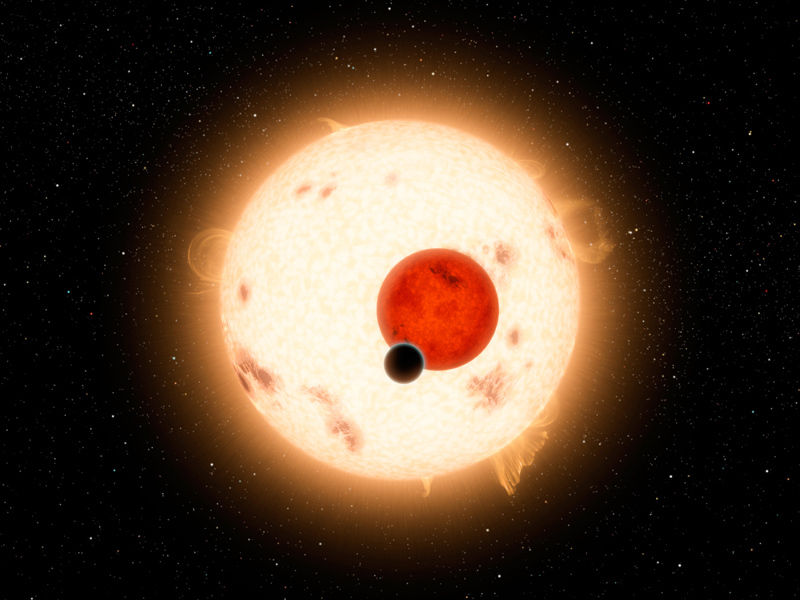News | August 20, 2013
Star flicker gives better estimates of exoplanet sizes

Astronomers have found a clever new way to slice and dice the flickering light from a distant star in a way that reveals the strength of gravity at its surface.
That is important because a star’s surface gravity is one of the key properties that astronomers use to calculate a star’s physical properties and assess its evolutionary state.
The new technique can also be used to significantly improve estimates of the sizes of the hundreds of exoplanets that have been discovered in the last 20 years. Current estimates have uncertainties ranging from 50 percent to 200 percent. Using the improved figures for the surface gravity of the host stars calculated by the new method should cut these uncertainties at least in half.
The technique was developed by a team of astronomers headed by Vanderbilt Professor of Physics and Astronomy Keivan Stassun and is described in the Aug. 22 issue of the journal Nature.
“Once you know a star’s surface gravity then you only need one other measurement, its temperature, which is pretty easy to obtain, to determine its mass, size and other important physical properties,” said Stassun.
“Measuring stellar surface gravities well has always been a difficult business,” added Gibor Basri, professor of astronomy at the University of California, Berkeley who contributed to the study. “So it is a very pleasant surprise to find that the subtle flickering of a star’s light provides a relatively easy way to do it.”
Measuring stellar gravity
There are three traditional methods for estimating a star’s surface gravity: photometric, spectroscopic and asteroseismic. The new flicker method is simpler than the older methods and more accurate than all but one of them.
Photometric methods look at how bright a star is in different colors. This distribution is linked to its surface gravity, temperature and chemical composition. It is a relatively easy observation to make and can be performed even on fairly faint stars, but does not produce a very accurate figure for surface gravity, having an uncertainty range of 90 to 150 percent.
The spectroscopic technique is more involved and is limited to relatively bright stars, but it has a lower uncertainty range of 25 to 50 percent. It works by closely examining the narrow spectral bands of light emitted by the elements in the star’s atmosphere. Generally speaking, high surface gravity widens the lines and lower surface gravity narrows them.
Asteroseismology is the gold standard, with accuracies of a few percent, but the measurements are even more difficult to make than spectroscopy and it is restricted to several hundred of the closest, brightest stars. The technique traces sound pulses that travel through the interior of a star at specific frequencies that are tied to its surface gravities. Small stars, like the sun, ring at a higher pitch while giant stars ring a lower pitch.
Much like asteroseismology, the new flicker method looks at variations in the star’s brightness, In this case it zeroes in on variations that last eight hours or less. These variations appear to be linked to granulation, the network of small cells that cover the surface of a star that are caused by columns of gas rising from the interior. On stars with high surface gravity, the granulation is finer and flickers at a higher frequency. On stars with low surface gravity, the granulation is coarser and they flicker at a lower frequency.
Exquisitely simple
The new method is remarkably simple – requiring only five lines of computer code to make the basic measurement – substantially reducing the cost and effort required to calculate the surface gravities of thousands of stars.
“The spectroscopic methods are like surgery. The analysis is meticulous and involved and very fine-grained,” said Stassun. “Flicker is more like ultrasound. You just run the probe around the surface and you see what you need to see. But its diagnostic power – at least for the purpose of measuring gravity – is as good if not better.”
To determine the accuracy of the flicker method, they used it to calculate the surface gravity of stars that have been analyzed using asteroseismology. They found that it has an uncertainty of less than 25 percent, which is better than both the photometric and spectroscopic methods. Its major limitation is that it requires extremely high quality data taken over long time periods. But this is precisely the type of observations made by Kepler while it was searching for periodic dips in light caused when exoplanets cross the face of a star. So the Flicker method can be applied to the tens of thousands of stars already being monitored by Kepler.
“The exquisite precision of the data from Kepler allows us to monitor the churning and waves on the surfaces of stars,” said team member Joshua Pepper, assistant professor of physics at Lehigh University. “This behavior causes subtle changes to a star’s brightness on the time scale of a few hours and tells us in great detail how far along these stars are in their evolutionary lifetimes.”
Playing with data yields discovery
Graduate student Fabienne Bastien was responsible for discovering that valuable information was embedded in starlight flicker. The discovery began when she was “playing around” with Kepler data using special data visualization software that Vanderbilt astronomers have developed for investigating large, multi-dimensional astronomy datasets. (The data visualization tool that enabled this discovery, called Filtergraph, is free to the public.)
“I was plotting various parameters looking for something that correlated with the strength of stars’ magnetic fields,” said Bastien. “I didn’t find it, but I did find an interesting correlation between certain flicker patterns and stellar gravity.”
When Bastien showed her discovery to Stassun, he was intrigued. So they performed the operation on the archived Kepler light curves of a few hundred sun-like stars.
When they plotted the overall variation in brightness of stars against their flicker intensity, they found an interesting pattern. As stars age, their overall variation falls gradually to a minimum. This is easily understood because the rate at which a star spins decreases gradually over time. As stars approach this minimum, their flicker begins to grow in complexity – a characteristic that the astronomers have labeled “crackle.” Once they reach this point, which they call the flicker floor, the stars appear to maintain this low level of variability for the rest of their lives, though it does appear to grow again as the stars approach the ends of their lives as red giant stars.
“This is an interesting new way to look at stellar evolution and a way to put our Sun’s future evolution into a grander perspective,” said Stassun.
When they ran their analysis on the sun’s light curve, for example, the researchers found that it is hovering just above the flicker floor, leading them to the prediction that the sun is approaching a time when it will undergo a fundamental transition to a state of minimum variability and, in the process, will lose its spots.
The research was funded by the Vanderbilt Initiative in Data-intensive Astrophysics (VIDA) and National Science Foundation grants AST-0849736 and AST-1009810.
Contact:
David Salisbury, (615) 322-NEWS
david.salisbury@vanderbilt.edu




